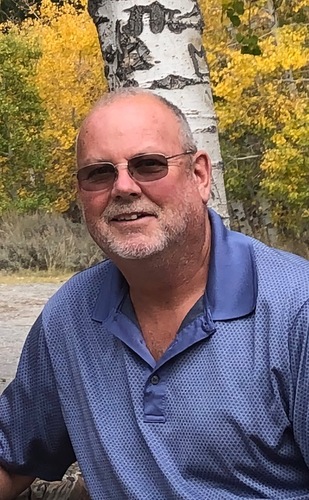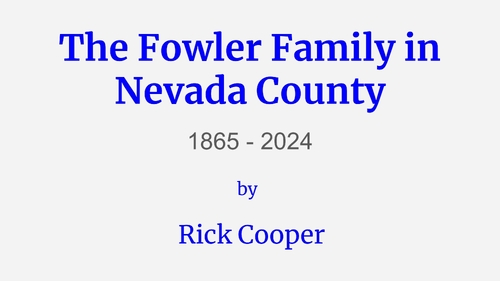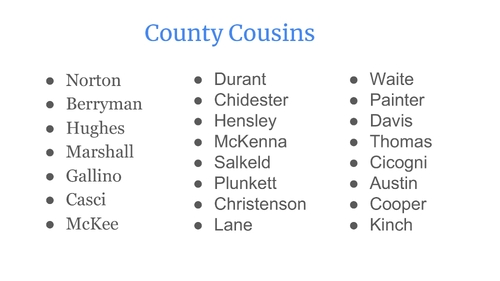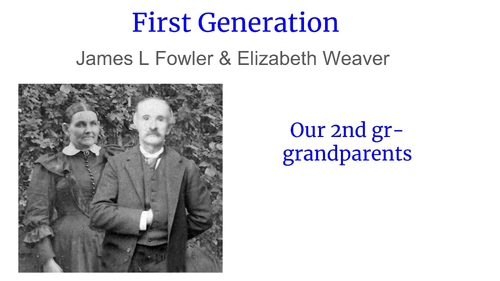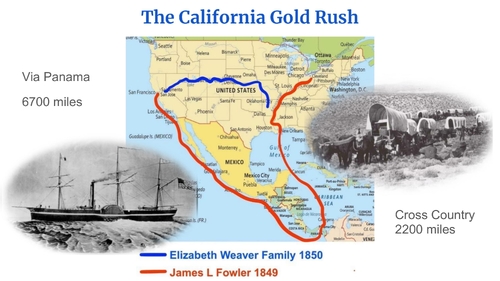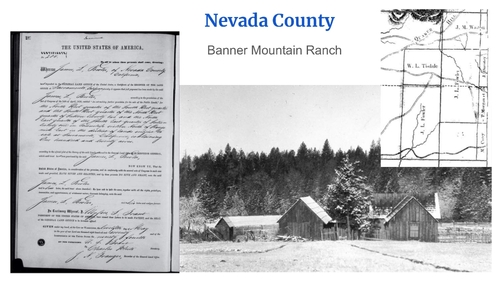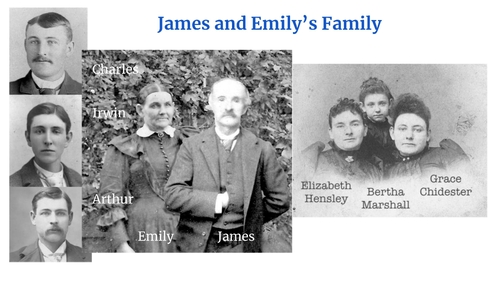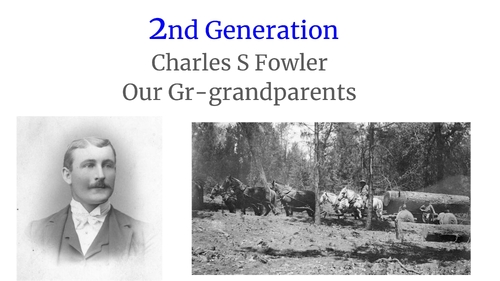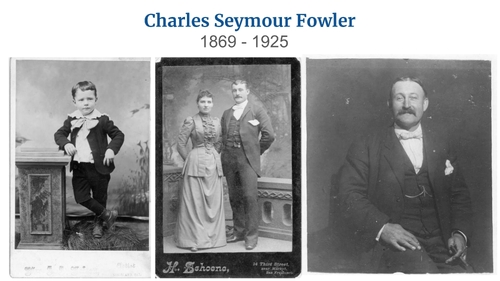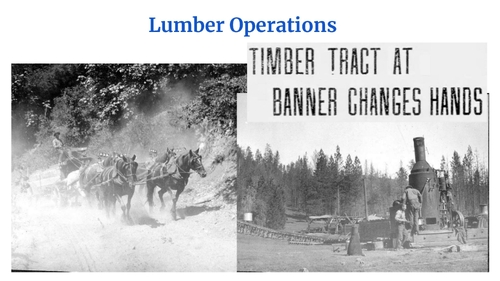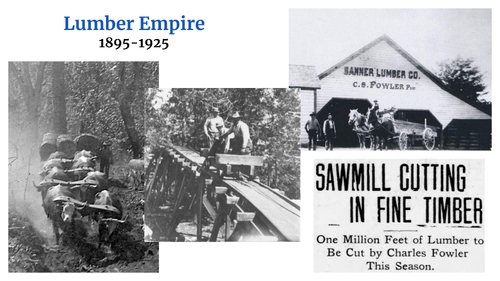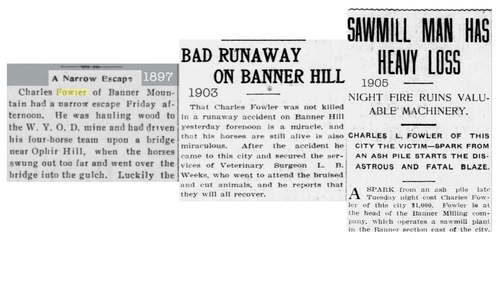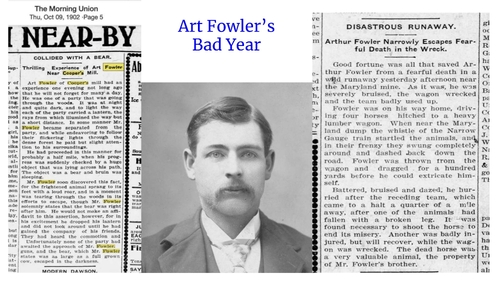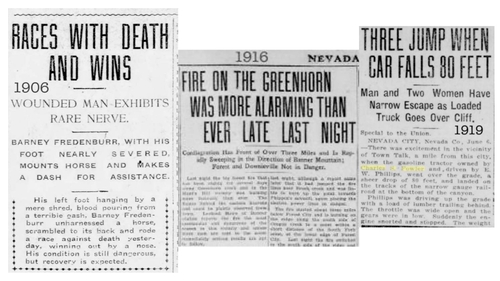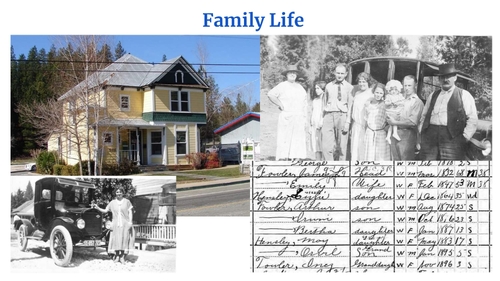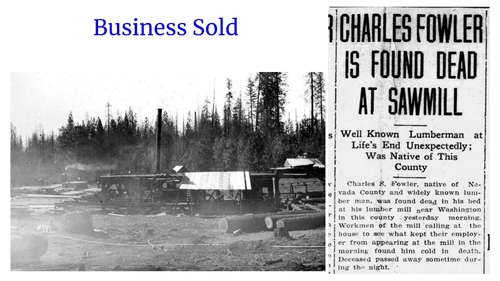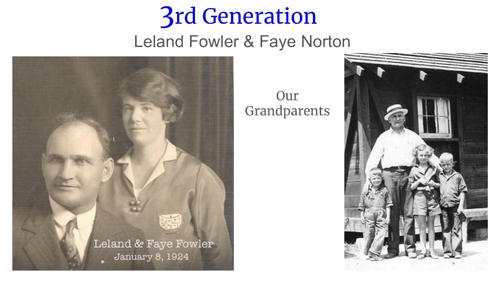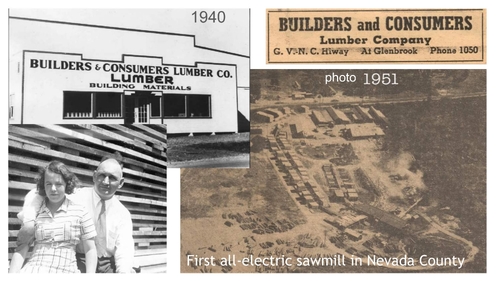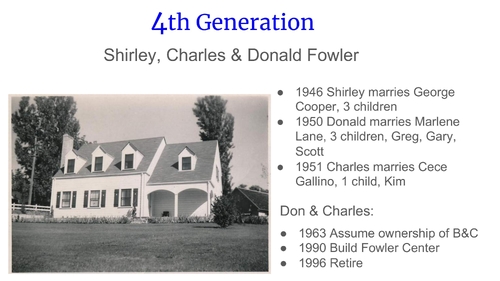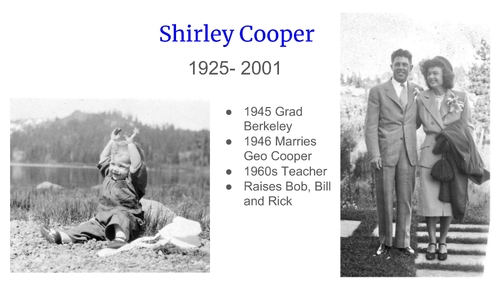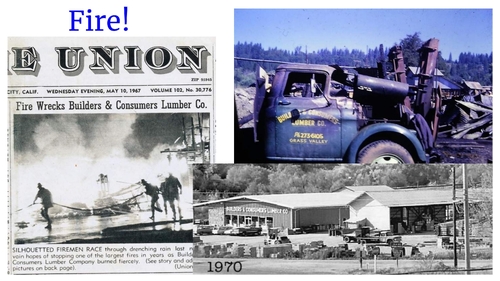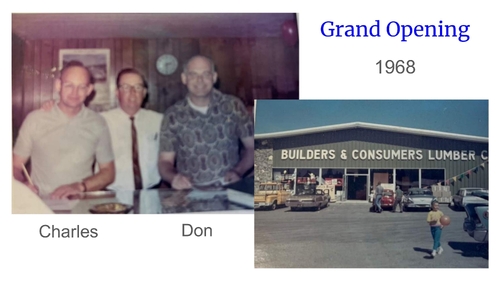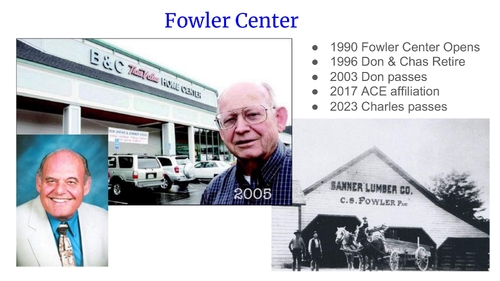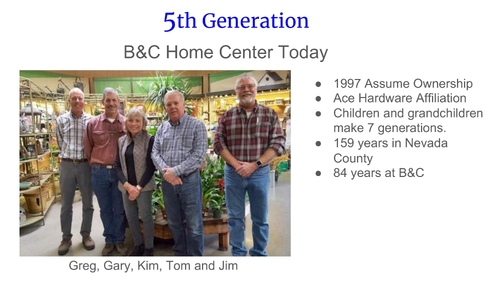Enter a name, company, place or keywords to search across this item. Then click "Search" (or hit Enter).
Collection: Videos > Speaker Nights
Video: 2024-05-16 - The History of the Fowler Family in Nevada County with Rick Cooper
This presentation will trace the classic emigrant story of the 1849 Gold Rush, settlement in California and homesteading in Nevada County. It will detail the journey of five generations of the Fowler family in the timber and lumber business culminating with the current B&C Home Center in Glenbrook Basin. The story is set against the development of Western Nevada County and the emigrant story will be familiar to many of our pioneer families. The story is told by Richard Cooper, son of Shirley Fowler and George Cooper.
Author: Rick Cooper
Published: 2024-05-16
Original Held At:
Published: 2024-05-16
Original Held At:
Full Transcript of the Video:
I think this time I'd like to introduce Rick Cooper, and he's going to tell you about his affiliation with the Ballard Valley. No further ado other than Rick does one of our Facebook posters, and if you can follow Facebook on our Facebook page, he's the one who's doing the historic photograph uploads. We have two people working on that for us. So thank you very much, Rick, and we look forward to your talk tonight. Switch on. [applause] Hey, Jans. Am I on? I'm live. Okay. Thanks everybody for coming, and it looks like a great crowd. It's really great to see you all. To introduce myself, I am Richard Cooper. My mom was Shirley Fowler Cooper, the oldest sister, older sister of Don and Charles Fowler, who many of you have known over the years, that ran and operated and owned Builders and Consumers Lumber Company in Blender. And now their children own and operate BNC Home Center in the same location in Glenborough. That is Greg and Connie Fowler, Gary and Arlene Fowler, and Kim and Tom Janisic. And they are the fifth generation lumbermen in Nevada County. And tonight we're going to talk to you a little bit about where those five generations came from and what they did to create the fabulous operation they have now. I need help. How do you go to the full screen here? [laughter] [applause] Okay. So, next slide please. Yep, that's the one. First, a little talk about genealogy. Genealogy is one of my hobbies, and it's a great thing to do on those winter nights in your home watching reruns on TV. And if any of you have thought about researching your family history, it's really a golden age of research right now. Because from like 1800 to now, there are so many records that various local, state, and federal governments have collected. And there's land titles and wills and so much available. And the United States Census, they can literally sit on your sofa at home and type on your laptop and come up with a wealth of information. And as I go through the presentation, I'll show you some of the little treasures I've found to illustrate how that could happen. Now, being here 159 years, we have acquired a lot of connections in the county. And through birth or marriage, we have a lot of cousins. A lot of us may be related in some way. If you recognize some of the names up there, those are some of the names that are in our family tree. Okay. Now, I'm trying to keep this organized so that you can understand it, and to keep me from getting confused. I've tried to organize this in making each generation a chapter. So, the first generation of Fowler's that have come to Nevada County were James L. and Elizabeth Weaver. The Fowler family actually goes back to medieval times, to 800 AD, to the first king of Germany, Henry the Fowler. He had a birdie hobby. And I discovered this by going through Ancestry. com, where everybody elaborates and collects family trees. I've actually been able to link Ancestry's back, online, back to Henry the Fowler. But we're not going to go through that. We don't have two weeks here. So, we'll start a little sooner. And we'll start our story in Ohio in 1846. Now, at that time, Bill Dad Fowler III passed away and left his farm to his children. And you can see one of the examples of genealogy research is, remarkably, his will is online. I was able to do some searching and find his actual will, digitized, and I was able to read it. And things weren't exactly equal back then. For example, one of the daughters got one cow. But on the other hand, luckily, James L. Fowler got several hundred dollars. The stipulation being that he couldn't get it until he turned 21. Well, you know what happened next. In 1849, word reached Ohio, the Gold Rush. And James L. got the boat. And he made his way down the Ohio River, down the Mississippi, and bought a through ticket to California in New Orleans. So, he sailed down the east coast of Mexico and reached Panama. And there in Panama, the miners would hire local natives to take them upriver, across the swampy lakes, over the mountains to the west coast of Panama, where he found about 400 other miners waiting for another ship to come by to pick them up. Well, it just so happens that the first ship that came by was the SS California. This was the first steamship to make its way to San Francisco. This was because the United States wanted to establish a presence on the west coast. And so they commissioned these steamships to carry mail and freight and passengers around the horn of South America from the east coast. So, the ship pulled in, and there's 400 people waiting there. But because Mr. Fowler had a through ticket, he was allowed on board with 40 other men. So, they settled up the west coast of Mexico, and either bad planning or not enough room, they ran out of coal. So, they had to start keep going into shore to scrounge for firewood. And so, they slowly made their way up the coast. And by the time they got to the California coast, they were burning the furniture and pulling up the deck boards on this new ship. So, finally, in 1849, he made it into San Francisco Bay. And it's interesting, another little piece of genealogy information, there are so many newspapers that are digitized and available online. And back then, if you've ever looked at the old newspapers, they carried everything. Who came in on the train, who left on the train, who was visiting who, who died, who was born, what everybody was doing. It was very gossipy. One article I found said that James L. Fowler was a member of the Society of Steamship Pioneers in San Francisco. So, he was recognized for that. So, and then if you know your grade school, Gold Rush history, you know that by this time, even at this early time, the easy gold was gone. Mining was hard work. And as you know, the foothills, like right now, they're very hot, of course, raining a lot. And pick and shovel work and classroom mining is very difficult. And some stuck to it, and others fell back and relied on the skills they had back east, like farming or team string or blacksmithing or what have you, wheel price. And so, that's what we think James L. did, that he did team string in the Central Valley, around Sacramento, and the North Valley for about 13 years. But also in 1850, another family decided to immigrate less. This was Dr. David Weaver and his wife Elizabeth, their one year old son John, and three year old daughter Emily. They sold the farm in Arkansas, loaded up the wagon, and traveled to Missouri, where they joined an immigrant train to California. And they basically walked to 2300 miles across country. And Elizabeth passed away in about 1912, and in her front page obituary in the Woodland newspaper, they used a paragraph from her diary. And in this paragraph they quoted from her diary. She describes some of the trials and tribulations of that trip. And one of them, I'll relate to you. When they got to eastern Nevada, or where Narmukah is, they got up in the morning to break camp, and they noticed a lot of the stock was gone. And so they sent three men, including Dr. Weaver, out to follow the tracks and get the stock back. Well, they went out, and they never came back. So they put together another group to go out and find them. And what they found was the three men did, surrounded by nine Indians, and with the stock grazing peacefully nearby. So they think that they fought to the last man because the stock was still there. So they buried their three companions and took the stock back, broke camp, and now the widow Elizabeth with the two toddlers continue on with the wagon train left. And it's really remarkable, you know. We grew up watching western movies and TV shows and stuff. And then to research this and find out in your own family that this stuff actually happened. It was pretty amazing. So anyway, they made their way across Nevada, doing the Carson City route, up Carson River Canyon, over Carson Pass, and ended up southwest of Placipo. Now we know this because it's 1850, and the United States is doing their census. They do it every decade. And I'm using the word "remarkably" a lot. It's true. Even in California, during the early stages of the Gold Rush, they did the United States census. So I found the weavers in the 1850 census, and as for a location that says, "Along the Consumnes River. " So they weren't even in a town. They were on some sandbar somewhere. And you see, some of the people, this is when they first started listing the occupations too. Some of the people were farmers, blacksmiths, wheelwrights, and things. Probably a part of the people on the wagon train. Another bunch that were listed were miners. So they were probably the ones already there, mining on this wagon train. So that's really something. That was really quite a find. And speaking of the diary, I don't know where the diary is, but it even exists, or who has it or what. I've been trying over the years to locate it, but that would sure be something to find. So the family spent the first year in Sacramento, and then they moved to Woodland in Nuevo County, where she was one of the first white women there. She married a widower rancher, and she opened a boarding house. They must have built a boarding house. So she went into business doing that. So as I mentioned, James L. was working around there as a teamster and such. And 13 years passes, and now the three-year-old Emily is 18, and she and James meet. And I found their wedding announcement in the Sacramento paper, in 1863. And in 1865, they moved to Nevada County. So they homesteaded a ranch on the south slope of Banner Mountains. And on the left here is the homestead application that's online. On the upper right is an old Nevada County map that's online, and you can see where J. L. Fowler is listed on a couple parcels there. We think it's about 128 acres on the Quaker Hill Road. And just to the southwest of that, if you know where it is, was the Banner of the Lava Cap Mine. And this is an actual photo of the ranch. There's somebody who I'll talk about a little later, our great aunt, Inez, who we call affectionately anti-eye. She graduated from Grants Valley High School in 1950, and I think she got a Kodak Brownie camera as a graduation present. Because soon after, I have two full albums of old 19-teens and 1920s photos. And this is one of them. Okay, next please. So throughout the presentation, we'll see some more of her photos that she took. So then, in this period from 1865 to 1895, besides the farm and combination ranch, he did some team strain on the side, and because we have such a wealth of timber, there are a lot of little small timber operations, and I think he was doing team strain for them, and he started to get into the business a little bit. I fell on his own trees doing all the sawmill work, but also they had six kids. So, the top left of the boys, Charles, Erwin, and Arthur. On the right are Elizabeth, Bertha, and Grace, and they married a Hensley, a Marshall, and a Chyna. And these were all guys that worked in the woods for the sawmills and things. So we got next here. Okay, let's go on. Okay, so now we can talk about the second generation. This is Charles S. Fowler, one of the James L. and Emily's children. He's the one that became the entrepreneur, lumberman, and businessman, and so he's the one we're going to concentrate on tonight. He was a very precocious boy and really took an interest in his father's businesses and what he was doing. And he learned a lot. His grandparents, and he had a lot of aunts and uncles down in Woodland, so early in his life he moved to Woodland. And one of the newspaper articles I found, it mentioned that he was a manager of a ranch in Woodland, as he was growing up at a young age. And at this time, go ahead and, oh, this is, oh, sorry Dan. This is another photo that Annie and I took of one of the Fowler logging operations. Okay, go ahead. Now here's some pictures of Charles throughout his life, and you can see on the left, he's got something going on. He's got some attitude. And that shows throughout his life. And the center photo is their wedding photo. He met Emma Blaine in Woodland, and they got married, and this photo's from San Francisco, so they told him that he was there. And this is Charles in about 1920 on the right, as a successful Grass Valley business man. Okay, Dan. Okay, so as, at some point, soon after their marriage, he moved back to Grass Valley, and he really started getting into the business. And he and his father started buying bigger lots of land to log. I guess that's what you did, Dan. You bought attractive land, logged it off, sold it, bought another tract of land, hopefully slightly bigger, more profitable. And also what they did, you know, you've probably seen pictures of these old sawmills, with these big timbers and these big, all this equipment, and the tents and whatever they had for the workers, and cook shack and all this. Every time they sold a tract of land, they'd have to turn it all down and move it to the new tract and rebuild it all and start working it. So there are many mentions of that in the union. In fact, the union newspaper is a great resource because from about 1860 to 1940, every issue is online, and there is such a wealth of information. We're really lucky to have that. And here's a photo that Nei took. So she graduated in 1950, and these are photos from about 1950 to 1920. They were still using horses and oxen back then. I like this photo of the lumber wagon because you notice each horse has a set of bells above its neck. And I was reading somewhere where the turns in our mountain roads back in the day were so sharp that that was a problem of teams and things running into each other. So there's evidence that they actually use bells to get a warning. And on the right is a donkey steam winch. They called it a donkey engine, but it's a steam-powered winch. And on the right there is some kind of trestle contraption that probably slid the logs down to the mill using that winch. And there's a headline from the union. "Timber tracked at Banner changes standing. " So they started small on Banner Hill, and another article talks about them logging the Greenhorn area, and then Hunts Hill, which I think is northeast of Greenhorn, and then the Scotts Flat Valley before the reservoir. And finally they ended up on Washington Ridge near the intersection of Highway 20 and Washington Road. They had a place called Phelps Hill. Now this is the, I think NEI went, took her camera and went up to the logging operation one time and took a bunch of photos of everything that was going on. So this is awesome being used with the wood-wheeled log wagon hauling logs through the mill. And in the middle we have some kind of trestle built over a bulge where the proton pile logs are lumber across the bulge. And Charles S. Fowler is in the front right there. So they started getting bigger and bigger operations, selling their lumber to local lumber yards. And it got to the point, well why not own the lumber yards? So it was an interesting time when you read the union of like 1900, 1903, 1905. There was a lot of activity in that area. It seemed like several of the old, I mean, lumber yard families were retiring. And Charles had the opportunity to step in and make deals with these folks. So the lumber yards on East Main Street at Bennett Street, which is where the new post office is that you know, that was an old lumber yard from way back. And you bought that and renamed that to Grass Valley Lumbert family. And also on South Lumbert Street, the Conaway family was retiring from the business too. And this lumber yard was across from the old Hennessy School where the gas station is now. And they bought that and renamed that Banner Lumbert family. C. S. Fowler for pride. And this headline says "SOMO Cutting and Fine Timber. One Billion Feet of Lumbert to be Cut by Charles Fowler this Season. " Okay Dan. So this is, let's see, I think he's good. Oh, okay. They're just out of sync. I'll adjust to the sync. That's all right. Okay, so in the Union, what I was mentioning is a wealth of information. There were a lot of throws and spills back in the day. Dangerous mists not only in the woods and at the sawmill. There was a couple of articles with people losing thoughts of things. But this article here from 1906 describes a lumber wagon accident. Charles Fowler of Banner Mountain had a narrow escape Friday afternoon. He was hauling wood to the WYOD mine and had driven his four-course team of modern bridge here over hill. But the horses swung out too far and went over the bilge. So the rest of the article describes how the wagon was destroyed but the horses were able to break their harnesses and scramble on safety. And they weren't very too bad. And neither was Charles. In the middle article from 1916, this describes a forest fire by the Greenhorn-Hemstell area. And by today, forest fires were always a danger back then. And at that night, before fire services and forest service, they would pull workers from the mines and the local sawmills and things to go fight these fires. Sometimes they were successful. This next article from 1905, this speaks of the sawmill that they had up on Banner Mountain. And the article describes how to prevent fire, they would go around at the end of every day and soak down all the sawdust, all the timbers, all the wood in the sawmill to try to prevent fire. Well, that worked great. Tell us one night. And for some reason, they could figure it out why. What happened? Some kind of a spark. The whole sawmill burned down. And as often happened in those days, they immediately rebuilt. Okay. Ah, here's the one on the second floor. This is Art Fowler, Charles' younger brother, and he worked in the woods. He worked for Art Cooper's sawmill in a relation. And this article describes an encounter they had one night when the men were, for some reason, walking through the woods on Washington Ridge. And they were each carrying a lantern, trying to follow each other through the woods. And for some reason, Art got separated from the group and went off trail and was trying to cut a shortcut and catch up to him. And it was very dark, the lanterns were very dim, and he stumbled over something big. Well, that something big jumped up and screamed and ran as fast as it could go to wait. Meanwhile, Art ran the other direction. Finally, he got in contact with his companions. They didn't have any guns or anything. They were a bit more running than a bear either. So I failed to get the sawmill. It's so neat, in these old articles, how the writers used to try to make the story entertaining. So it goes on to say how Art tried to say that he scared the bear and chased it away. [laughter] And all this, and the guys were the brave ones. But everybody was kind of. Anyway, in the next article, this was another Beigenbrag. If you're familiar with Idaho, Maryland Road, where the old Idaho, Maryland mine was, there's an old photo that shows the mine. And then the narrow gauge railroad tracks go right by it. And then a road going right by it. It's much the same layout there is today without no railroad. But he was driving a lumber wagon towards Banner Mountain. Go home. And the train came by and sounded its whistle at the mine. And this startled the horses, and they swung around 180 degrees with the loaded wagon. He was thrown off, and apparently it was tangled in the reins because they said he was drunk 100 yards until it finally stopped. Because tragically this time one of the horses had a broken leg. So they got to shoot the horse, and the other one recovered, and so did Art. He brought work another day. But I think what's interesting in this article is, it says, "The dead horse was a very valuable animal, the property of Mr. Bowers's brother. " So that implies that the horses were very important and very valuable, and were generally and probably hopefully well taken care of. Okay. Oh, okay. We just. . . oh, okay. [laughter] This is in 1906, and an employee of Charles's. He was a teamster, you know, lumber wagon. And he got down off the wagon with his axe to clear a log from the air rug. And, of course, you know, axes. He glanced off and almost cut his ankle off. And he was bleeding profusely. So he crawled to the wagon, unharnessed what the newspaper calls the gentlest of the horse, and rode it to the pile of ranch on Battermount, where they tried to stem the flow of blood. And at this time, they actually had a telephone there. So they called the doctor, and the doctor came in his boat, and stopped the bleeding and saved the man's life. I found a later article that says that though he was recovering slowly, they were able to save the foot. Okay. 1916, another fire on the green horn. They were able to subdue before it burned up the fella or something else. And this is one of my, on the right, it's one of my favorite stories. This is in 1990, and Charles had a motor tractor. Even then in 1990, they were struggling with that, what they called trucks. And he had this, if you can imagine, if you've seen the old Mack trucks and things, these fuzzy little trucks hauling these big loads of lumber. They also had a trailer with a big little mower on them. And this was going up the hill towards Town Tock from Nevada State, probably about where Robinson Timber is now, where there you are. It was going up the hill, and a little four-cylinder engine sputtered and died. And it started rolling backwards. And the brakes weren't sufficient enough to stop it. So the driver and his wife and her friend, what they were doing on there, were able to jump off to safety. And about that time, the trailer jackknifed and went over the cliff, 80 feet down onto the Nevada County narrow gauge railroad tracks. And they said that the lumber was stacked perfectly on the tracks. [laughter] But the trailer and tractor were destroyed. [laughter] So I guess that was Charles' first adventure with trucks. So anyway, they got a delay. The unit trained in Nevada City. Tell was off cleaned up, and they took the passengers and trained around by bus. Okay. So now we have a little family life here. We'll get into that. In about 1896, James L. and Emily decided to retire from their ranch at Denver County. So they built a house down at Hills Flat, the 500 one. And this house is still there. They built a house at Hills Flat. I think it's an engineering office now. And there was a large garden and a barn in the back, and it was quite a big property. In fact, in the 1910 census, you can see who was living there. There was the grandparents, Lizzie, and Arthur, and May, three of the children. And well under Irwin, too, and Bertha. Oh, I'm just going to author it. And a grandson and our auntie, I. And on the left is a photo of Auntie I and with her model team. She, after graduation in 1950, she went to Chico to go to teacher school. And she started off in Summit Valley, went to Potesso, and had a career teaching in Sacramento. Okay. So now we're up to the third generation. Charles and Emma had two children, Leland and I. Leland is our grandmother. And that was in 1894, and I. I. And tragically, Emma died in childhood with her. And. Wrong slide. I'll go on this side. Okay. Yeah. There we go. There's the third generation, Leland and Kay. Okay. So, Charles had lost his wife. He had two young children. Their grandparents helped raise Leland and I. And when Leland was a young age, his teenage years, he began to work with his father, Charles, in the lumber business. And so he started to work at the Lumbrie Yard in T. Cross Valley. And, oh, I forgot to mention about the Lumbrie Yard purchases. They purchased another one, the Cooper Lumbrie Yard in Nevada City, which is no relation. And that was on Sacramento Street. Those Cooper's retired and Charles got the son on his manager. So Leland was growing up in the business. In fact, at one time in an early age, he actually managed the banner lumber. So, let's see here. Okay. They had, well, in 1924, Leland met Mae Norton, our grandmother. And the Nortons came from Washington State. And at this time, Charles and Leland were living on Walheim Avenue next to the Lumbrie Yard on South Army Street. And the Nortons happened to move in, and they had three girls. And so Mae got together, Leland and Faye. And Faye's sister, Zoe, married Clarence Berryman, and that's our Berryman connection. Now, on the right here, we have the family on the family trip. Faye's obviously taking the picture. But there's Don on the left, Mother Shirley in the middle, and Charles on the right. Okay. Let's see if we can go forward. Let's see. Let me skip that. Let's go back. Okay. That one. Okay. This is one of any, another one of any photos. Well, that's fortuitous, because that keeps things in line, because those kids got married in 1924. And in 1925, Charles was found dead and saw him. And it fell still. And this is Annie Lye's photo of that son up there on Washington Bridge. And so this event, totally unexpected. He didn't show up for work in the morning, so he went to his gat in the work morning, and he was dead and dead. He was about 54 years old. And so this set in motion a big transition. After his beloved wife Emma died in childbirth, he married a woman named Stacia Green. My mom said it was a book, a new song. And so when he died, mom said that Cleveland and Stacia realized they couldn't be business partners. And so they decided to liquidate the whole operation. The sawmills, most of the land, the three lumber yards, and everything. So this time, Cleveland and Fay were fairly wealthy, so they sold everything off. And this was like 1926, 1927, and they got all this wrapped up. And then the Depression hit, and luckily they were fairly well off at that time. So they moved to Sacramento and subsequently had three children. My mom Shirley, and then Charles in 1927, and Donald in 1930. And by 1930, they were living comfortably in Sacramento, and they loved the outdoors. They did a lot of camping, they did a lot of driving around, a lot of sightseeing. And they had a great time. He was playing a stock market and doing other business things on the side. But my mom said later, like 1938 or so, she was starting to grow up. She was about 13 years old. She was over camping. And they decided, and the boys, Charles and Donald, were getting older. And to help give them direction and a future, Fay and Charles decided to go back into business. So at home I've got a big cardboard box of brochures, of sawmill equipment and maps, and trade magazines and things that chronicle all the research you did. So they settled on the 14 acres in Dwebboro. In 1940 they bought that, and they came up and he built a whole, un-sawmill, lumberyard retail operation on that one site. And it was the first all-in-one sawmill in Nevada County. And you can see here the log pond, the sawmill, the planting mill, drying stacks, and up at the top was the retail building that a lot of us old-timers remember. So there's a photo of Fay and Leland at the time, and the front of the old building. Okay, let's see what we've got next. Okay, now we're off into the fourth generation. These are our parents, Shirley, Charles, and Donald. Adjacent to the property where the mobile station is now, in West Olympia and Nevada City Highway, we built this nice house. And Fay grew up in it, and us kids, my cousins and I, we played in it as kids. And in fact, I was talking to one of the, a woman who used to be one of the little girls in the neighborhood, and she said that she referred to it as "Grandma's house. " [laughter] We all congregated there, I guess. And it was so much fun to be a kid growing up in this neighborhood. My parents and us lived in Black Rock Heights, a couple blocks to the west, and Grandma was here, and the lubber yard was to the right, and in between was the swamp. And they had built a wood catwalk to get from the house to the lubber yard to go to work through the swamp. And to us kids, oh my God, it was full of snakes and alligators and sand. [laughter] So now I have to throw in a bit about my family and my mom. Shirley was born in 1925, passed away in 2001. This is a picture of her at Bucks Lake on her first birthday. As I said, they were in the camping and adventuring. And she graduated UC Berkeley in 1945, and in 1946 she married my dad, George Cooper. And that's a cute story, because George was a local baseball star, and even though he was just the son of a Ford minor, I think that helped get him a job at P. J. A. And then World War II came along. He played for the baseball team from about 1933 to 1940. And during World War II he went into the Marines, and he was sent to the South Pacific. And as part of his duties, he played baseball for the Marines for morale purposes, and even played on the 3rd Marine Division All-Star team. That's a pretty cool thing. Yeah, with a couple of pro players too. And so after the war he came back, you know, a baseball star, a P. J. A. job, a Marine veteran, but he was still terrible with girls. If something runs in our family, he was very shy. So my mom, you know, she was from a prominent family. You see she's pretty cute there. She was also very shy, and she was going nowhere in the Panther Memorial Department. But fortunately, her cousin Beverly Berryman worked for PG&E also. If you went into the Main Street office to pay her bills, she was the one you had to counter the U. P. B. bill for like 30 years. But in 1946 she saw the situation with her cousin. She saw this handsome guy named PG&E that was going nowhere. And she played matchmaker and got them together. And I still have some letters from her to my mom saying, "Oh, I was at the town dance Saturday night, and there was George standing by himself by the Blue Heater. " [laughter] So luckily, thank you Beverly. It worked out very well for me. [laughter] So, we're just going to head here a little bit somehow, I don't know what to say again, but we'll catch up. So, in the 50s, a lot of things happened. My parents got married, and then Don and Marlene Lane got married, and they had three children, Greg, Gary, and Scott. And then Charles married Cece Galeno, and they had one daughter, Kim. And to repeat the past, like with Leland with his father and Charles with his father, the boys got into the business at an early age. I remember going to the over yard and playing and working, pulling leaves and getting free coats out of the machine. But eventually, Donald's three kids, Greg, Gary, and Scott, they were actually employees, and learning the trade, and growing up there, and taking on more and more responsibility. But in 1963, Leland passed away, and her grandmother Fay decided to go retire and go fishing. So, that's what she did. And Don and Charles took over the ownership and operation of the loose-wing service at that time, and started running it themselves very successfully. But, in 1967, there was a disastrous fire, and consumed the office, the retail section, some sheds that were attached, the trucks, the forkless, the oysters, and everything. And so that, in good old pioneer tradition, they swept everything away, and a year later, they built this steel building with a much bigger retail space. So, they decreased the concentration on the actual milling and production of lumber, and went more into the retail direction, which I think was brilliant, not very expert for this. Okay, next. And here we are at the Grand Open A, and there's a young Charles and Don there, which was a murder cause. Kodak really ruined photography, I guess you'd say, with those Instamatic cameras. Even photos 120 years ago were better than these. So, and there's the front of the building there. It's so familiar to a lot of us, isn't it? Okay, next. So then, by 1990, Don and Charles wondered what to do next, where direction to go. And so they decided to enter in agreement with Albertson stores to redevelop the Lumberyard into a commercial center. And so they did that, and they built the Fowler Center. In 1996, they retired and passed the ownership and operation onto my cousins, Greg, Gary, and Ken. And in 2003, Don passed away in 2017. They got the Ace of Deliation, they started a little work of deliation, and then 2023 Charles passed. And since that time, the Fowler family has been in business since 1865, 159 years in Nevada County. And 84 years of builders and consumers, or BNC, at the same location. Quite a legacy, and the family's doing a great job of carrying that on. And so, next slide please. Okay, the last slide we've got, we're gonna say, "Yeah. " So here they are in the store, that's Greg, Gary, Jim, Jim's husband, Tom, and son-in-law, Jim. And so, that brings you up to date on where we came from, how we got to where we are now, and I thank my cousin's uncle, the grandparents and grand-fathers who were around a little while ago. Okay, thank you everybody.
I think this time I'd like to introduce Rick Cooper, and he's going to tell you about his affiliation with the Ballard Valley. No further ado other than Rick does one of our Facebook posters, and if you can follow Facebook on our Facebook page, he's the one who's doing the historic photograph uploads. We have two people working on that for us. So thank you very much, Rick, and we look forward to your talk tonight. Switch on. [applause] Hey, Jans. Am I on? I'm live. Okay. Thanks everybody for coming, and it looks like a great crowd. It's really great to see you all. To introduce myself, I am Richard Cooper. My mom was Shirley Fowler Cooper, the oldest sister, older sister of Don and Charles Fowler, who many of you have known over the years, that ran and operated and owned Builders and Consumers Lumber Company in Blender. And now their children own and operate BNC Home Center in the same location in Glenborough. That is Greg and Connie Fowler, Gary and Arlene Fowler, and Kim and Tom Janisic. And they are the fifth generation lumbermen in Nevada County. And tonight we're going to talk to you a little bit about where those five generations came from and what they did to create the fabulous operation they have now. I need help. How do you go to the full screen here? [laughter] [applause] Okay. So, next slide please. Yep, that's the one. First, a little talk about genealogy. Genealogy is one of my hobbies, and it's a great thing to do on those winter nights in your home watching reruns on TV. And if any of you have thought about researching your family history, it's really a golden age of research right now. Because from like 1800 to now, there are so many records that various local, state, and federal governments have collected. And there's land titles and wills and so much available. And the United States Census, they can literally sit on your sofa at home and type on your laptop and come up with a wealth of information. And as I go through the presentation, I'll show you some of the little treasures I've found to illustrate how that could happen. Now, being here 159 years, we have acquired a lot of connections in the county. And through birth or marriage, we have a lot of cousins. A lot of us may be related in some way. If you recognize some of the names up there, those are some of the names that are in our family tree. Okay. Now, I'm trying to keep this organized so that you can understand it, and to keep me from getting confused. I've tried to organize this in making each generation a chapter. So, the first generation of Fowler's that have come to Nevada County were James L. and Elizabeth Weaver. The Fowler family actually goes back to medieval times, to 800 AD, to the first king of Germany, Henry the Fowler. He had a birdie hobby. And I discovered this by going through Ancestry. com, where everybody elaborates and collects family trees. I've actually been able to link Ancestry's back, online, back to Henry the Fowler. But we're not going to go through that. We don't have two weeks here. So, we'll start a little sooner. And we'll start our story in Ohio in 1846. Now, at that time, Bill Dad Fowler III passed away and left his farm to his children. And you can see one of the examples of genealogy research is, remarkably, his will is online. I was able to do some searching and find his actual will, digitized, and I was able to read it. And things weren't exactly equal back then. For example, one of the daughters got one cow. But on the other hand, luckily, James L. Fowler got several hundred dollars. The stipulation being that he couldn't get it until he turned 21. Well, you know what happened next. In 1849, word reached Ohio, the Gold Rush. And James L. got the boat. And he made his way down the Ohio River, down the Mississippi, and bought a through ticket to California in New Orleans. So, he sailed down the east coast of Mexico and reached Panama. And there in Panama, the miners would hire local natives to take them upriver, across the swampy lakes, over the mountains to the west coast of Panama, where he found about 400 other miners waiting for another ship to come by to pick them up. Well, it just so happens that the first ship that came by was the SS California. This was the first steamship to make its way to San Francisco. This was because the United States wanted to establish a presence on the west coast. And so they commissioned these steamships to carry mail and freight and passengers around the horn of South America from the east coast. So, the ship pulled in, and there's 400 people waiting there. But because Mr. Fowler had a through ticket, he was allowed on board with 40 other men. So, they settled up the west coast of Mexico, and either bad planning or not enough room, they ran out of coal. So, they had to start keep going into shore to scrounge for firewood. And so, they slowly made their way up the coast. And by the time they got to the California coast, they were burning the furniture and pulling up the deck boards on this new ship. So, finally, in 1849, he made it into San Francisco Bay. And it's interesting, another little piece of genealogy information, there are so many newspapers that are digitized and available online. And back then, if you've ever looked at the old newspapers, they carried everything. Who came in on the train, who left on the train, who was visiting who, who died, who was born, what everybody was doing. It was very gossipy. One article I found said that James L. Fowler was a member of the Society of Steamship Pioneers in San Francisco. So, he was recognized for that. So, and then if you know your grade school, Gold Rush history, you know that by this time, even at this early time, the easy gold was gone. Mining was hard work. And as you know, the foothills, like right now, they're very hot, of course, raining a lot. And pick and shovel work and classroom mining is very difficult. And some stuck to it, and others fell back and relied on the skills they had back east, like farming or team string or blacksmithing or what have you, wheel price. And so, that's what we think James L. did, that he did team string in the Central Valley, around Sacramento, and the North Valley for about 13 years. But also in 1850, another family decided to immigrate less. This was Dr. David Weaver and his wife Elizabeth, their one year old son John, and three year old daughter Emily. They sold the farm in Arkansas, loaded up the wagon, and traveled to Missouri, where they joined an immigrant train to California. And they basically walked to 2300 miles across country. And Elizabeth passed away in about 1912, and in her front page obituary in the Woodland newspaper, they used a paragraph from her diary. And in this paragraph they quoted from her diary. She describes some of the trials and tribulations of that trip. And one of them, I'll relate to you. When they got to eastern Nevada, or where Narmukah is, they got up in the morning to break camp, and they noticed a lot of the stock was gone. And so they sent three men, including Dr. Weaver, out to follow the tracks and get the stock back. Well, they went out, and they never came back. So they put together another group to go out and find them. And what they found was the three men did, surrounded by nine Indians, and with the stock grazing peacefully nearby. So they think that they fought to the last man because the stock was still there. So they buried their three companions and took the stock back, broke camp, and now the widow Elizabeth with the two toddlers continue on with the wagon train left. And it's really remarkable, you know. We grew up watching western movies and TV shows and stuff. And then to research this and find out in your own family that this stuff actually happened. It was pretty amazing. So anyway, they made their way across Nevada, doing the Carson City route, up Carson River Canyon, over Carson Pass, and ended up southwest of Placipo. Now we know this because it's 1850, and the United States is doing their census. They do it every decade. And I'm using the word "remarkably" a lot. It's true. Even in California, during the early stages of the Gold Rush, they did the United States census. So I found the weavers in the 1850 census, and as for a location that says, "Along the Consumnes River. " So they weren't even in a town. They were on some sandbar somewhere. And you see, some of the people, this is when they first started listing the occupations too. Some of the people were farmers, blacksmiths, wheelwrights, and things. Probably a part of the people on the wagon train. Another bunch that were listed were miners. So they were probably the ones already there, mining on this wagon train. So that's really something. That was really quite a find. And speaking of the diary, I don't know where the diary is, but it even exists, or who has it or what. I've been trying over the years to locate it, but that would sure be something to find. So the family spent the first year in Sacramento, and then they moved to Woodland in Nuevo County, where she was one of the first white women there. She married a widower rancher, and she opened a boarding house. They must have built a boarding house. So she went into business doing that. So as I mentioned, James L. was working around there as a teamster and such. And 13 years passes, and now the three-year-old Emily is 18, and she and James meet. And I found their wedding announcement in the Sacramento paper, in 1863. And in 1865, they moved to Nevada County. So they homesteaded a ranch on the south slope of Banner Mountains. And on the left here is the homestead application that's online. On the upper right is an old Nevada County map that's online, and you can see where J. L. Fowler is listed on a couple parcels there. We think it's about 128 acres on the Quaker Hill Road. And just to the southwest of that, if you know where it is, was the Banner of the Lava Cap Mine. And this is an actual photo of the ranch. There's somebody who I'll talk about a little later, our great aunt, Inez, who we call affectionately anti-eye. She graduated from Grants Valley High School in 1950, and I think she got a Kodak Brownie camera as a graduation present. Because soon after, I have two full albums of old 19-teens and 1920s photos. And this is one of them. Okay, next please. So throughout the presentation, we'll see some more of her photos that she took. So then, in this period from 1865 to 1895, besides the farm and combination ranch, he did some team strain on the side, and because we have such a wealth of timber, there are a lot of little small timber operations, and I think he was doing team strain for them, and he started to get into the business a little bit. I fell on his own trees doing all the sawmill work, but also they had six kids. So, the top left of the boys, Charles, Erwin, and Arthur. On the right are Elizabeth, Bertha, and Grace, and they married a Hensley, a Marshall, and a Chyna. And these were all guys that worked in the woods for the sawmills and things. So we got next here. Okay, let's go on. Okay, so now we can talk about the second generation. This is Charles S. Fowler, one of the James L. and Emily's children. He's the one that became the entrepreneur, lumberman, and businessman, and so he's the one we're going to concentrate on tonight. He was a very precocious boy and really took an interest in his father's businesses and what he was doing. And he learned a lot. His grandparents, and he had a lot of aunts and uncles down in Woodland, so early in his life he moved to Woodland. And one of the newspaper articles I found, it mentioned that he was a manager of a ranch in Woodland, as he was growing up at a young age. And at this time, go ahead and, oh, this is, oh, sorry Dan. This is another photo that Annie and I took of one of the Fowler logging operations. Okay, go ahead. Now here's some pictures of Charles throughout his life, and you can see on the left, he's got something going on. He's got some attitude. And that shows throughout his life. And the center photo is their wedding photo. He met Emma Blaine in Woodland, and they got married, and this photo's from San Francisco, so they told him that he was there. And this is Charles in about 1920 on the right, as a successful Grass Valley business man. Okay, Dan. Okay, so as, at some point, soon after their marriage, he moved back to Grass Valley, and he really started getting into the business. And he and his father started buying bigger lots of land to log. I guess that's what you did, Dan. You bought attractive land, logged it off, sold it, bought another tract of land, hopefully slightly bigger, more profitable. And also what they did, you know, you've probably seen pictures of these old sawmills, with these big timbers and these big, all this equipment, and the tents and whatever they had for the workers, and cook shack and all this. Every time they sold a tract of land, they'd have to turn it all down and move it to the new tract and rebuild it all and start working it. So there are many mentions of that in the union. In fact, the union newspaper is a great resource because from about 1860 to 1940, every issue is online, and there is such a wealth of information. We're really lucky to have that. And here's a photo that Nei took. So she graduated in 1950, and these are photos from about 1950 to 1920. They were still using horses and oxen back then. I like this photo of the lumber wagon because you notice each horse has a set of bells above its neck. And I was reading somewhere where the turns in our mountain roads back in the day were so sharp that that was a problem of teams and things running into each other. So there's evidence that they actually use bells to get a warning. And on the right is a donkey steam winch. They called it a donkey engine, but it's a steam-powered winch. And on the right there is some kind of trestle contraption that probably slid the logs down to the mill using that winch. And there's a headline from the union. "Timber tracked at Banner changes standing. " So they started small on Banner Hill, and another article talks about them logging the Greenhorn area, and then Hunts Hill, which I think is northeast of Greenhorn, and then the Scotts Flat Valley before the reservoir. And finally they ended up on Washington Ridge near the intersection of Highway 20 and Washington Road. They had a place called Phelps Hill. Now this is the, I think NEI went, took her camera and went up to the logging operation one time and took a bunch of photos of everything that was going on. So this is awesome being used with the wood-wheeled log wagon hauling logs through the mill. And in the middle we have some kind of trestle built over a bulge where the proton pile logs are lumber across the bulge. And Charles S. Fowler is in the front right there. So they started getting bigger and bigger operations, selling their lumber to local lumber yards. And it got to the point, well why not own the lumber yards? So it was an interesting time when you read the union of like 1900, 1903, 1905. There was a lot of activity in that area. It seemed like several of the old, I mean, lumber yard families were retiring. And Charles had the opportunity to step in and make deals with these folks. So the lumber yards on East Main Street at Bennett Street, which is where the new post office is that you know, that was an old lumber yard from way back. And you bought that and renamed that to Grass Valley Lumbert family. And also on South Lumbert Street, the Conaway family was retiring from the business too. And this lumber yard was across from the old Hennessy School where the gas station is now. And they bought that and renamed that Banner Lumbert family. C. S. Fowler for pride. And this headline says "SOMO Cutting and Fine Timber. One Billion Feet of Lumbert to be Cut by Charles Fowler this Season. " Okay Dan. So this is, let's see, I think he's good. Oh, okay. They're just out of sync. I'll adjust to the sync. That's all right. Okay, so in the Union, what I was mentioning is a wealth of information. There were a lot of throws and spills back in the day. Dangerous mists not only in the woods and at the sawmill. There was a couple of articles with people losing thoughts of things. But this article here from 1906 describes a lumber wagon accident. Charles Fowler of Banner Mountain had a narrow escape Friday afternoon. He was hauling wood to the WYOD mine and had driven his four-course team of modern bridge here over hill. But the horses swung out too far and went over the bilge. So the rest of the article describes how the wagon was destroyed but the horses were able to break their harnesses and scramble on safety. And they weren't very too bad. And neither was Charles. In the middle article from 1916, this describes a forest fire by the Greenhorn-Hemstell area. And by today, forest fires were always a danger back then. And at that night, before fire services and forest service, they would pull workers from the mines and the local sawmills and things to go fight these fires. Sometimes they were successful. This next article from 1905, this speaks of the sawmill that they had up on Banner Mountain. And the article describes how to prevent fire, they would go around at the end of every day and soak down all the sawdust, all the timbers, all the wood in the sawmill to try to prevent fire. Well, that worked great. Tell us one night. And for some reason, they could figure it out why. What happened? Some kind of a spark. The whole sawmill burned down. And as often happened in those days, they immediately rebuilt. Okay. Ah, here's the one on the second floor. This is Art Fowler, Charles' younger brother, and he worked in the woods. He worked for Art Cooper's sawmill in a relation. And this article describes an encounter they had one night when the men were, for some reason, walking through the woods on Washington Ridge. And they were each carrying a lantern, trying to follow each other through the woods. And for some reason, Art got separated from the group and went off trail and was trying to cut a shortcut and catch up to him. And it was very dark, the lanterns were very dim, and he stumbled over something big. Well, that something big jumped up and screamed and ran as fast as it could go to wait. Meanwhile, Art ran the other direction. Finally, he got in contact with his companions. They didn't have any guns or anything. They were a bit more running than a bear either. So I failed to get the sawmill. It's so neat, in these old articles, how the writers used to try to make the story entertaining. So it goes on to say how Art tried to say that he scared the bear and chased it away. [laughter] And all this, and the guys were the brave ones. But everybody was kind of. Anyway, in the next article, this was another Beigenbrag. If you're familiar with Idaho, Maryland Road, where the old Idaho, Maryland mine was, there's an old photo that shows the mine. And then the narrow gauge railroad tracks go right by it. And then a road going right by it. It's much the same layout there is today without no railroad. But he was driving a lumber wagon towards Banner Mountain. Go home. And the train came by and sounded its whistle at the mine. And this startled the horses, and they swung around 180 degrees with the loaded wagon. He was thrown off, and apparently it was tangled in the reins because they said he was drunk 100 yards until it finally stopped. Because tragically this time one of the horses had a broken leg. So they got to shoot the horse, and the other one recovered, and so did Art. He brought work another day. But I think what's interesting in this article is, it says, "The dead horse was a very valuable animal, the property of Mr. Bowers's brother. " So that implies that the horses were very important and very valuable, and were generally and probably hopefully well taken care of. Okay. Oh, okay. We just. . . oh, okay. [laughter] This is in 1906, and an employee of Charles's. He was a teamster, you know, lumber wagon. And he got down off the wagon with his axe to clear a log from the air rug. And, of course, you know, axes. He glanced off and almost cut his ankle off. And he was bleeding profusely. So he crawled to the wagon, unharnessed what the newspaper calls the gentlest of the horse, and rode it to the pile of ranch on Battermount, where they tried to stem the flow of blood. And at this time, they actually had a telephone there. So they called the doctor, and the doctor came in his boat, and stopped the bleeding and saved the man's life. I found a later article that says that though he was recovering slowly, they were able to save the foot. Okay. 1916, another fire on the green horn. They were able to subdue before it burned up the fella or something else. And this is one of my, on the right, it's one of my favorite stories. This is in 1990, and Charles had a motor tractor. Even then in 1990, they were struggling with that, what they called trucks. And he had this, if you can imagine, if you've seen the old Mack trucks and things, these fuzzy little trucks hauling these big loads of lumber. They also had a trailer with a big little mower on them. And this was going up the hill towards Town Tock from Nevada State, probably about where Robinson Timber is now, where there you are. It was going up the hill, and a little four-cylinder engine sputtered and died. And it started rolling backwards. And the brakes weren't sufficient enough to stop it. So the driver and his wife and her friend, what they were doing on there, were able to jump off to safety. And about that time, the trailer jackknifed and went over the cliff, 80 feet down onto the Nevada County narrow gauge railroad tracks. And they said that the lumber was stacked perfectly on the tracks. [laughter] But the trailer and tractor were destroyed. [laughter] So I guess that was Charles' first adventure with trucks. So anyway, they got a delay. The unit trained in Nevada City. Tell was off cleaned up, and they took the passengers and trained around by bus. Okay. So now we have a little family life here. We'll get into that. In about 1896, James L. and Emily decided to retire from their ranch at Denver County. So they built a house down at Hills Flat, the 500 one. And this house is still there. They built a house at Hills Flat. I think it's an engineering office now. And there was a large garden and a barn in the back, and it was quite a big property. In fact, in the 1910 census, you can see who was living there. There was the grandparents, Lizzie, and Arthur, and May, three of the children. And well under Irwin, too, and Bertha. Oh, I'm just going to author it. And a grandson and our auntie, I. And on the left is a photo of Auntie I and with her model team. She, after graduation in 1950, she went to Chico to go to teacher school. And she started off in Summit Valley, went to Potesso, and had a career teaching in Sacramento. Okay. So now we're up to the third generation. Charles and Emma had two children, Leland and I. Leland is our grandmother. And that was in 1894, and I. I. And tragically, Emma died in childhood with her. And. Wrong slide. I'll go on this side. Okay. Yeah. There we go. There's the third generation, Leland and Kay. Okay. So, Charles had lost his wife. He had two young children. Their grandparents helped raise Leland and I. And when Leland was a young age, his teenage years, he began to work with his father, Charles, in the lumber business. And so he started to work at the Lumbrie Yard in T. Cross Valley. And, oh, I forgot to mention about the Lumbrie Yard purchases. They purchased another one, the Cooper Lumbrie Yard in Nevada City, which is no relation. And that was on Sacramento Street. Those Cooper's retired and Charles got the son on his manager. So Leland was growing up in the business. In fact, at one time in an early age, he actually managed the banner lumber. So, let's see here. Okay. They had, well, in 1924, Leland met Mae Norton, our grandmother. And the Nortons came from Washington State. And at this time, Charles and Leland were living on Walheim Avenue next to the Lumbrie Yard on South Army Street. And the Nortons happened to move in, and they had three girls. And so Mae got together, Leland and Faye. And Faye's sister, Zoe, married Clarence Berryman, and that's our Berryman connection. Now, on the right here, we have the family on the family trip. Faye's obviously taking the picture. But there's Don on the left, Mother Shirley in the middle, and Charles on the right. Okay. Let's see if we can go forward. Let's see. Let me skip that. Let's go back. Okay. That one. Okay. This is one of any, another one of any photos. Well, that's fortuitous, because that keeps things in line, because those kids got married in 1924. And in 1925, Charles was found dead and saw him. And it fell still. And this is Annie Lye's photo of that son up there on Washington Bridge. And so this event, totally unexpected. He didn't show up for work in the morning, so he went to his gat in the work morning, and he was dead and dead. He was about 54 years old. And so this set in motion a big transition. After his beloved wife Emma died in childbirth, he married a woman named Stacia Green. My mom said it was a book, a new song. And so when he died, mom said that Cleveland and Stacia realized they couldn't be business partners. And so they decided to liquidate the whole operation. The sawmills, most of the land, the three lumber yards, and everything. So this time, Cleveland and Fay were fairly wealthy, so they sold everything off. And this was like 1926, 1927, and they got all this wrapped up. And then the Depression hit, and luckily they were fairly well off at that time. So they moved to Sacramento and subsequently had three children. My mom Shirley, and then Charles in 1927, and Donald in 1930. And by 1930, they were living comfortably in Sacramento, and they loved the outdoors. They did a lot of camping, they did a lot of driving around, a lot of sightseeing. And they had a great time. He was playing a stock market and doing other business things on the side. But my mom said later, like 1938 or so, she was starting to grow up. She was about 13 years old. She was over camping. And they decided, and the boys, Charles and Donald, were getting older. And to help give them direction and a future, Fay and Charles decided to go back into business. So at home I've got a big cardboard box of brochures, of sawmill equipment and maps, and trade magazines and things that chronicle all the research you did. So they settled on the 14 acres in Dwebboro. In 1940 they bought that, and they came up and he built a whole, un-sawmill, lumberyard retail operation on that one site. And it was the first all-in-one sawmill in Nevada County. And you can see here the log pond, the sawmill, the planting mill, drying stacks, and up at the top was the retail building that a lot of us old-timers remember. So there's a photo of Fay and Leland at the time, and the front of the old building. Okay, let's see what we've got next. Okay, now we're off into the fourth generation. These are our parents, Shirley, Charles, and Donald. Adjacent to the property where the mobile station is now, in West Olympia and Nevada City Highway, we built this nice house. And Fay grew up in it, and us kids, my cousins and I, we played in it as kids. And in fact, I was talking to one of the, a woman who used to be one of the little girls in the neighborhood, and she said that she referred to it as "Grandma's house. " [laughter] We all congregated there, I guess. And it was so much fun to be a kid growing up in this neighborhood. My parents and us lived in Black Rock Heights, a couple blocks to the west, and Grandma was here, and the lubber yard was to the right, and in between was the swamp. And they had built a wood catwalk to get from the house to the lubber yard to go to work through the swamp. And to us kids, oh my God, it was full of snakes and alligators and sand. [laughter] So now I have to throw in a bit about my family and my mom. Shirley was born in 1925, passed away in 2001. This is a picture of her at Bucks Lake on her first birthday. As I said, they were in the camping and adventuring. And she graduated UC Berkeley in 1945, and in 1946 she married my dad, George Cooper. And that's a cute story, because George was a local baseball star, and even though he was just the son of a Ford minor, I think that helped get him a job at P. J. A. And then World War II came along. He played for the baseball team from about 1933 to 1940. And during World War II he went into the Marines, and he was sent to the South Pacific. And as part of his duties, he played baseball for the Marines for morale purposes, and even played on the 3rd Marine Division All-Star team. That's a pretty cool thing. Yeah, with a couple of pro players too. And so after the war he came back, you know, a baseball star, a P. J. A. job, a Marine veteran, but he was still terrible with girls. If something runs in our family, he was very shy. So my mom, you know, she was from a prominent family. You see she's pretty cute there. She was also very shy, and she was going nowhere in the Panther Memorial Department. But fortunately, her cousin Beverly Berryman worked for PG&E also. If you went into the Main Street office to pay her bills, she was the one you had to counter the U. P. B. bill for like 30 years. But in 1946 she saw the situation with her cousin. She saw this handsome guy named PG&E that was going nowhere. And she played matchmaker and got them together. And I still have some letters from her to my mom saying, "Oh, I was at the town dance Saturday night, and there was George standing by himself by the Blue Heater. " [laughter] So luckily, thank you Beverly. It worked out very well for me. [laughter] So, we're just going to head here a little bit somehow, I don't know what to say again, but we'll catch up. So, in the 50s, a lot of things happened. My parents got married, and then Don and Marlene Lane got married, and they had three children, Greg, Gary, and Scott. And then Charles married Cece Galeno, and they had one daughter, Kim. And to repeat the past, like with Leland with his father and Charles with his father, the boys got into the business at an early age. I remember going to the over yard and playing and working, pulling leaves and getting free coats out of the machine. But eventually, Donald's three kids, Greg, Gary, and Scott, they were actually employees, and learning the trade, and growing up there, and taking on more and more responsibility. But in 1963, Leland passed away, and her grandmother Fay decided to go retire and go fishing. So, that's what she did. And Don and Charles took over the ownership and operation of the loose-wing service at that time, and started running it themselves very successfully. But, in 1967, there was a disastrous fire, and consumed the office, the retail section, some sheds that were attached, the trucks, the forkless, the oysters, and everything. And so that, in good old pioneer tradition, they swept everything away, and a year later, they built this steel building with a much bigger retail space. So, they decreased the concentration on the actual milling and production of lumber, and went more into the retail direction, which I think was brilliant, not very expert for this. Okay, next. And here we are at the Grand Open A, and there's a young Charles and Don there, which was a murder cause. Kodak really ruined photography, I guess you'd say, with those Instamatic cameras. Even photos 120 years ago were better than these. So, and there's the front of the building there. It's so familiar to a lot of us, isn't it? Okay, next. So then, by 1990, Don and Charles wondered what to do next, where direction to go. And so they decided to enter in agreement with Albertson stores to redevelop the Lumberyard into a commercial center. And so they did that, and they built the Fowler Center. In 1996, they retired and passed the ownership and operation onto my cousins, Greg, Gary, and Ken. And in 2003, Don passed away in 2017. They got the Ace of Deliation, they started a little work of deliation, and then 2023 Charles passed. And since that time, the Fowler family has been in business since 1865, 159 years in Nevada County. And 84 years of builders and consumers, or BNC, at the same location. Quite a legacy, and the family's doing a great job of carrying that on. And so, next slide please. Okay, the last slide we've got, we're gonna say, "Yeah. " So here they are in the store, that's Greg, Gary, Jim, Jim's husband, Tom, and son-in-law, Jim. And so, that brings you up to date on where we came from, how we got to where we are now, and I thank my cousin's uncle, the grandparents and grand-fathers who were around a little while ago. Okay, thank you everybody.
Zoom Out
Zoom In (Please allow time for high-res images to load)
Zoom: 100%




